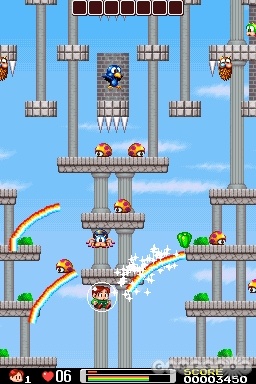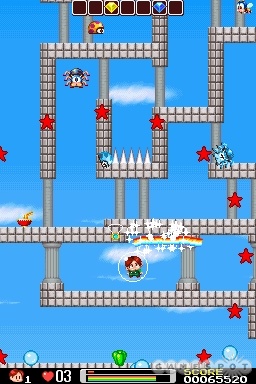Rainbow Islands Revolution for the Nintendo DS is basically the same Rainbow Islands that has appeared on countless consoles during the past 20 years, except that the controls and gameplay have been reworked to take advantage of the handheld's touch screen. What used to be a standard 2D platformer, with jump and attack buttons, has been transformed into something entirely new that uses the touch screen almost exclusively. The graphics, audio, and overall gameplay still come across as decidedly old school, but this touch-centric platformer does at least manage to revive a classic in a way that some people should find interesting.

Like most platform games, the goal in Rainbow Islands Revolution is to guide the main character to the furthest reaches of the screen while dodging and attacking enemies. Generally speaking, the furthest reaches of the screen are up, up, up. In the original game, you used a joystick to move the character around and pressed buttons in order to make him jump or unfurl a rainbow. Rainbows would knock out enemies on contact and could be used as steps to reach lofty platforms. In this Nintendo DS remake, all movements and actions are controlled using the stylus and touch screen. You drag your character, now stuck inside a bubble, using the stylus. There's no need to jump anymore because the bubble can float, but you still need to watch out for any enemies or spikes that may peck away at your character's health. Instead of pushing a button to cast rainbows directly in front of your character, you can now use the stylus to draw them anywhere on the screen. There are even special shapes that can be drawn to capture or vacuum up enemies.
The "boy in the bubble" motif doesn't really change the fact that all you're ever doing is avoiding enemies, grabbing power-ups, and pressing to the goal line, but it does make the game seem livelier than a typical old-school platformer. Between pulling the bubble through spiky tunnels and slashing rainbows across whatever enemies and power-ups appear, the stylus is always being put to use. Those power-ups mainly refill your rainbow meter and contribute to your score, although there are a couple of power-ups that can blast away all of the enemies on both screens. Some aspects of the game had to be tweaked to account for the new input method and the hero's transformation into a floating bubble boy, but these changes generally tend to work to the game's benefit. The time limits are longer, for example, and the bubble can now absorb multiple hits before popping. One especially sweet change is that all of the bosses at the end of each world have new attack patterns and require new strategies to beat. There are times when the touch screen doesn't respond fast enough, or it will mistake your attempt to drag the bubble as an attempt to draw a rainbow, but these instances are uncommon and rarely hazardous, thanks to all of the life points you'll usually have in reserve.
If there's one prevailing criticism, it's that this remake wasn't remade enough. Apart from showing an extra portion of the level on the upper screen while you maneuver around on the lower screen, the graphics haven't changed much since the original arcade game. The backdrops and characters are colorful and flaunt some shading here and there, but nothing beyond what was common in arcades back in the late 1980s. Thankfully, the scenery isn't garish. Some of the environments are downright cute, particularly those patterned after a toy land or a haunted graveyard. The music and sound effects are similarly cute and catchy, although they, too, come across as simplistic compared to what we've become accustomed to within the past five years or so.

A few more levels, or at least some new ones, would have been nice. The DS game has all of the same levels as the original arcade game. There are 40 in all, split into 10 worlds. That seemed like a lot back in the day, but most players will be able to blow through them in a day or two, thanks to the extra life points and continues provided by this version of the game. There's some replay involved in gathering up remaining crystals to see the best ending, but even that won't take dedicated players more than a few hours. Of course, you could argue that the game doesn't overstay its welcome either. The only new additions in terms of features are the score attack and multiplayer modes, which are similar to one another. In the score attack mode, you try to get the highest score possible in any of 10 different levels. In the multiplayer mode, as many as four players can compete to see who can amass the highest score in any of 10 different levels. You can't interact with the other players in a multiplayer game, but you can send enemies to your friends' screens by clearing them from yours. These modes are OK for what they are, although it is a shame that such a simple multiplayer mode requires each player to have a copy of the game.
For various reasons, Rainbow Islands Revolution falls just short of the mass-appeal plateau that other touch-centric games, like Kirby: Canvas Curse and Mario vs. Donkey Kong 2, inhabit. The changes that were made to revamp the classic game for the touch screen help freshen it up somewhat, but this is still a very old game, and more should have been done to justify its existence as a full-priced release in the Nintendo DS library.